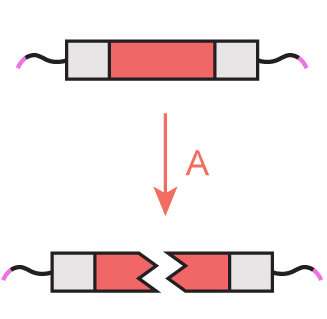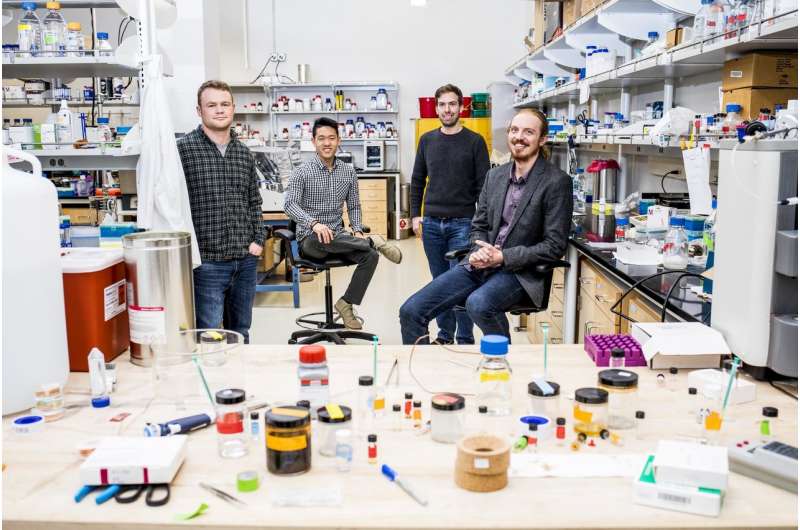Researchers program biomaterials with 'logic gates' that release therapeutics in response to environmental triggers

Drug treatments can save lives, but sometimes they also carry unintended costs. After all, the same therapeutics that target pathogens and tumors can also harm healthy cells.
To reduce this collateral damage, scientists have long sought specificity in drug delivery systems: A package that can encase a therapeutic and will not disgorge its toxic cargo until it reaches the site of treatment—be it a tumor, a diseased organ or a site of infection.
In a paper published Jan. 15 in the journal Nature Chemistry, scientists at the University of Washington announced that they have built and tested a new biomaterial-based delivery system—known as a hydrogel—that will encase a desired cargo and dissolve to release its freight only when specific physiological conditions are met. These environmental cues could include the presence of an enzyme or even the acidic conditions that could be found in a tumor microenvironment. Critically, the triggers that cause dissolution of the hydrogel can be switched out easily in the synthesis process, allowing researchers to create many different packages that open up in response to unique combinations of environmental cues.
The team, led by UW chemical engineering assistant professor Cole DeForest, designed this hydrogel using the same principles behind simple mathematical logic statements—those at the heart of basic programming commands in computer science.
"The modular strategy that we have developed permits biomaterials to act like autonomous computers," said DeForest, who is also a member of both the Institute for Stem Cell & Regenerative Medicine and the Molecular Engineering & Sciences Institute. "These hydrogels can be programmed to perform complex computations based on inputs provided exclusively by their local environment. Such advanced logic-based operations are unprecedented, and should yield exciting new directions in precision medicine."

Hydrogels are more than 90 percent water; the remainder consists of networks of biochemical polymers. Hydrogels can be engineered to ferry a variety of therapeutics, such as pharmaceutical products, special cells or signaling molecules, for purposes including drug delivery or even 3-D tissue engineering for transplantation into patients.
The key to the team's innovation lies in the way the hydrogels were synthesized. When researchers assembled the polymer network that comprises the biomaterial, they incorporated chemical "cross-link" gates that are designed to open and release the hydrogel's contents in response to user-specified cues—much like how the locked gates in a fence will only "respond," or open with a specific set of keys.
"Our 'gates' consist of chemical chains that could—for example—be cleaved only by an enzyme that is uniquely produced in certain tissues of the body; or be opened only in response to a particular temperature or specific acidic conditions," said DeForest. "With this specificity, we realized we could more generally design hydrogels with gates that would open if only certain chemical conditions—or logic statements—were met."
DeForest and his team built these hydrogel gates using simple principles of Boolean logic, which centers on inputs to simple binary commands: "YES," "AND" or "OR." The researchers started out by building three types of hydrogels, each with a different "YES" gate. They would only open and release their test cargo—fluorescent dye molecules—in response to their specific environmental cue.

One of the "YES" gates they designed is a short peptide—one of the constituent parts of cellular proteins. This peptide gate can be cleaved by an enzyme known as matrix metalloprotease (MMP). If MMP is absent, the gate and hydrogel remain intact. But if the enzyme is present in a cell or tissue, then MMP will slice the peptide gate and the hydrogel will burst open, releasing its contents. A second "YES" gate that the researchers designed consists of a synthetic chemical group called an ortho-nitrobenzyl ester (oNB). This chemical gate is immune to MMP, but it can be cleaved by light. A third "YES" gate contains a disulfide bond, which breaks upon reaction with chemical reductants but not in response to light or MMP. A hydrogel containing one of these types of "YES" gates is essentially "programmed" to respond to its physiological surroundings using the Boolean logic of its cross-link gate. A hydrogel with an oNB gate, for example, will open and release its contents in the presence of light, but not any of the other cues like the MMP enzyme or a chemically reductive environment.
They also created and tested hydrogels with multiple types of "YES" gates, essentially creating hydrogels with gates that would open and release their cargo in response to multiple combinations of environmental cues, not just one cue: light AND enzyme; reductant OR light; enzyme AND light AND reductant. Hydrogels with these more complex types of gates could still carry cargo, either fluorescent dyes or living cells, and release it only in response to the particular gate's unique combination of environmental triggers.
The team even tested how well a hydrogel with an "AND" gate—reductant and the enzyme MMP—could ferry the chemotherapy drug doxorubicin. The doxorubicin-containing hydrogel was mixed with cultures of tumor-derived HeLa cells, which doxorubicin should kill easily. But the hydrogel remained intact, and the HeLa cancer cells remained alive unless the researchers added both triggers for the "AND" gate: MMP and reductant. One cue alone was insufficient to cause HeLa cell demise.
DeForest and his team are building on these results to pursue even more complex gates. After all, specificity is the goal, both in medicine and tissue engineering.
"Our hope is that, by applying Boolean principles to hydrogel design, we can create a class of truly smart therapeutic delivery systems and tissue engineering tools with ever-greater specificity for organs, tissues or even disease states such as tumor environments," said DeForest. "Using these design principles, the only limits could be our imagination."
More information: Engineered modular biomaterial logic gates for environmentally triggered therapeutic delivery, Nature Chemistry (2018). nature.com/articles/doi:10.1038/nchem.2917
Journal information: Nature Chemistry
Provided by University of Washington



















